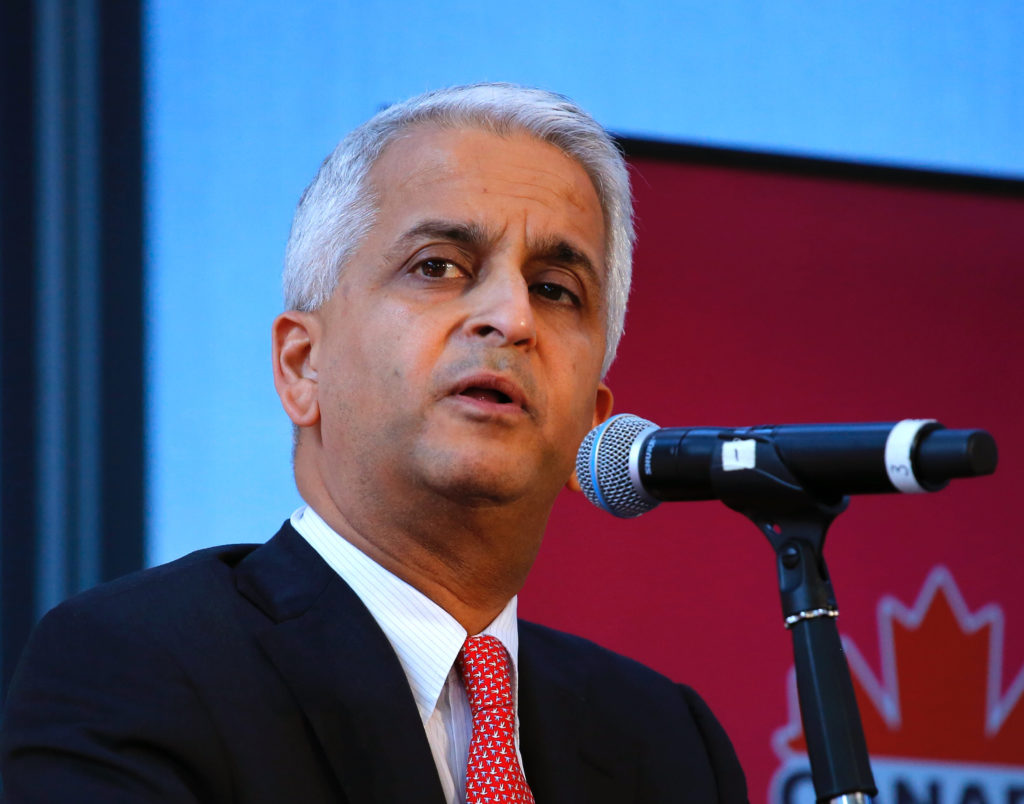World Cup failure prompts calls for US soccer ‘revolution’

This file photo taken on April 10, 2017 shows Sunil Gulati, President of United States Soccer Federation, speaking at a press conference in New York./ AFP PHOTO / KENA BETANCUR
COUVA, Trinidad—When soccer holds its world’s fair in Russia next June, the American pavilion will be glaringly absent.
A bumbling, stumbling, tumbling World Cup qualifying campaign ended Tuesday night with a calamitous 2-1 loss to already eliminated Trinidad and Tobago, the 99th-ranked nation in the world, when merely a tie was necessary to eke out the final automatic World Cup berth from one of soccer’s weakest regions.
“Unacceptable,” tweeted former Health and Human Services Secretary Donna Shalala, a U.S. Soccer Federation board member. “For us in USSoccer more than a wake-up call. Time for revolution. Need long term plan that is smart.”
After American soccer’s Waterloo, the fallout almost surely will lead to a new coach and possibly a new USSF head. There also figure to be calls for a reexamination of the player development structure, from youth teams through academies designed with the hope of producing elite prospects.
“There is no denying that this is a setback for all of us involved with the game in our country,” Major League Soccer said in a statement.
New York Cosmos owner Rocco Commisso, chairman of the lower-level North American Soccer League that has sued the USSF, called for federation President Sunil Gulati to resign along with board members and senior administrators he put in place.
“In the almost 12 years during which Sunil Gulati has been the USSF’s president, little or nothing has been done to enhance our prospects,” Commisso said in a statement. “The leadership of U.S. Soccer has failed all of its stakeholders: players, fans, sponsors and those of us who have invested in professional soccer. Getting back on track requires fundamental change in the structure and management of the sport in our country, starting with a change in the federation’s leadership.”
While fans fulminated over the front office, the next national team coach must instigate a ruthless roster purge. The Tim Howard/Clint Dempsey/Michael Bradley era is over, and pretty much any player older than 26 will be past his past his prime when the World Cup in Qatar kicks off in November 2022. The Americans won’t even play a competitive match for nearly two years, until the 2019 CONCACAF Gold Cup.
By then, Christian Pulisic, at 19 already the top American, should be surrounded with other players on the rise, such as 19-year-old midfielder Weston Mckennie, who has started Schalke’s last three games in the German Bundesliga. Haji Wright, a 19-year-old winger loaned from Schalke to second-division Sandhausen, is another top prospect along with forward Josh Sargent, who agreed last month to sign with Werder Bremen on his 18th birthday in February
Matt Miazga and Cameron Carter-Vickers should be tested in defense as the team reorients to 2022.
A shocked Gulati was measured in his reaction.
“You don’t have wholesale changes based on the ball being 2 inches wide or 2 inches in,” he said. “We will look at everything, obviously, and all of our programs, both the national team and all the development stuff. But we’ve got a lot of pieces in place that we think are very good and have been coming along.”
The U.S. returned to the World Cup in 1990 after a 40-year absence, and soccer grew at an exponential rate, helped by the U.S. hosting the tournament in 1994. Major League Soccer launched two years later; cable television and the Internet brought top European clubs to American televisions and later laptops and cell phones.
European clubs discovered there was huge money to be made by playing preseason exhibitions across the pond, growing the sport’s audience.
American sponsors started treating soccer like a major sport, if not at the level of the NFL, baseball and the NBA, at least as prominent as the NHL, golf and tennis.
Still, the national team peaked with its quarterfinal appearance at the 2002 World Cup. The U.S. failed to qualify for the 2012 and 2016 men’s Olympic soccer tournaments, a generational talent gap evident when a creaky defense repeatedly broke down during qualifying. There were no young goalkeepers considered challengers to Howard and Brad Guzan.
“This has been coming for a while. I think it’s just kind of been building up,” former U.S. defender Marcelo Balboa said Wednesday.
Elected head of the USSF in 2006 after a quarter-century helping build the national team and federation, Gulati has not said whether he will seek a fourth and final four-year term in February.
More immediately, a decision must be made on whether the national team plays exhibitions during the November fixture dates and who will coach. Bruce Arena, brought back when Jurgen Klinsmann was fired last November after a 0-2 start in the hexagonal, figures to depart later this year or next.
Among the possible American candidates are Tab Ramos, coach of the U.S. under-20 team since 2011; Peter Vermes, coach of Sporting Kansas City since 2009; and Huddersfield manager David Wagner. Atlanta United’s Tata Martino, a former coach of Argentina and Barcelona, is among the foreigners who could be considered. An interim coach is a possibility.
Surprisingly, Arena said no major shifts need to be made in the federation’s operations.
“There’s nothing wrong with what we’re doing,” he maintained. “Certainly I think as our league continues to grow, it benefits the national team program. We have some good young players coming up. Nothing has to change. To make any kind of crazy changes I think would be foolish. We’re building a good system in our professional league. We have players playing abroad of some quality. There’s enough there.”